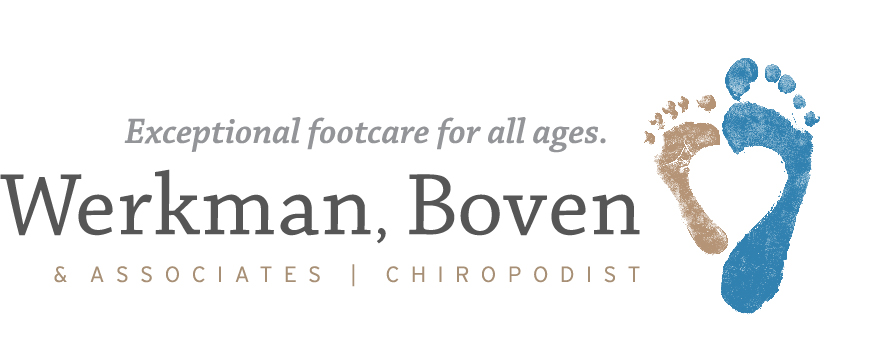Foot Related Conditions
Sports-Related Foot Problems
Participating in sports always has a risk of injury. Common Sports Injuries can include:
- Stress fractures
- Sprains
- Bursitis
- Metatarsalgia
- Heel spur syndrome
- Plantar fasciitis
- Shin splints
- Tendinitis
- Runner’s knee
- Hamstring injuries
Other foot problems which can impact sports participation are ingrown toenails, bleeding under the nail, blisters and onychomycosis (fungal infection).
did you know?
The average person takes 8,000 to 10,000 steps a day which covers several miles. In a lifetime, it amounts to about 193,000 kilometres—more than four times around the earth.
Stress Fractures
Stress fractures are small cracks in bones that often develop from chronic, excessive impact and poor foot function. In runners, the bones of the midfoot (metatarsals) are especially prone to these fractures.
Sprains
Sprains are an injury to a ligament 一 the tough, fibrous tissue that connects bones to other bones. Sprains typically occur when people fall and land on an outstretched arm, slide into base, land on the side of their foot, or twist a knee with the foot planted firmly on the ground. This results in an overstretch or tear of the ligament supporting that joint.
Strain
Strain is an injury to either a muscle or a tendon, the tissue that connects muscles to bones. Depending on the severity of the injury, a strain may be a simple overstretch of the muscle or tendon, or it can result in a partial or complete tear. An acute strain is caused by trauma or an injury such as a blow to the body or improperly lifting heavy objects. Chronic strains are usually the result of overuse – prolonged, repetitive movement of the muscles and tendons.
Bursitis
Bursitis is an inflammation of the fluid-filled sac (bursa) located between the skin and the tendon. Typically only one bursa is found in the heel, between the Achilles tendon and the heel bone, which may become inflamed, swollen, and painful.
Metatarsalgia
Metatarsalgia is a general term for pain in the metatarsophalangeal joints (ball of the foot). The most common causes include Freiberg’s disease, interdigital nerve pain (Morton’s Neuroma 一 Interdigital nerve irritation), and capsulitis. These can be diagnosed in a clinical setting.
Heel Spurs
Heel spurs are a painful condition caused by calcium deposits on the base of the heel, putting pressure on other areas of the feet.
Plantar fasciitis (Heel Pain)
Plantar fasciitis is commonly referred to as heel pain. The inflammation of the dense band of tissue called the plantar fascia extends from the bottom of the heel bone to the base of the toes.
Shin Splints
Shin splints are injuries to the front of the outer leg. While the exact injury is unknown, shin splints seem to result from injury to the tendon and adjacent tissues in the front of the outer leg. Shin splints represent one member of a group of injuries called “overuse injuries” and commonly occur in runners or aggressive walkers.
Achilles Tendinitis
Achilles Tendinitis is an inflammation of the tendon or sheath surrounding the Achilles Tendon located near the mid-calf. Symptoms include pain behind the heel, ankle, and lower calf when you do weight-bearing exercises. Whatever physical activity you do, protect your feet by wearing the right athletic shoes for the activity. Also, make sure to stretch out your feet and leg muscles, including calves and hamstrings, before and after each exercise.
Runner’s Knee
Runner’s knee (Patellofemoral Stress Syndrome) is a condition in which the kneecap (patella) rubs against the end of the thigh bone (femur) when the knee moves. Typically, the kneecap moves up or down slightly without touching the thigh bone during running. If the feet excessively pronate (the lower leg twists inward) pulling the kneecap inward, while the quadriceps muscles pull the kneecap outward. These opposing forces cause the back of the kneecap to rub against the end of the thigh bone, resulting in pain. Often custom-made foot orthotics are required to assist the foot in performing correctly biomechanically.
Hamstring Injury
A hamstring injury is an injury to the muscles in the back of the thigh. The hamstrings, which straighten the hip and bend the knee, are weaker than the opposing quadriceps muscles, at the front of your thigh. If the hamstrings are not at least 60% as strong as the quadriceps, the quadriceps overpower and injure the hamstrings. Immediate treatment includes; R.I.C.E. therapy: Rest, Ice, Compression (adhesive strapping), and Elevation. Then after healing begins, stretch and strengthening exercises can prevent re-injury.
Ingrown Toenail
An ingrown toenail is a condition in which the edges of the nail grow into the surrounding skin. The area can be red and warm and is prone to infection if not treated. If infected, the area becomes painful and swollen, and pus-filled blisters may develop and drain.
Fungal Infection
Onychomycosis is a fungal infection of the nails. Most commonly, as part of an infection called Athlete’s Foot. While mild infections may produce few or no symptoms, in severe infections, the nails turn white to yellow-brown, thicken, and detach from the nail bed.
Bleeding Under the Nail (Subungual Hematoma)
A subungual hematoma is a common injury to tennis players, soccer players, and runners due to the impact of the big toe or the longest toe against the upper of the shoe. Blood from ruptured capillaries collects under the toenail, causing pressure and pain. Treatment is required to allow blood to escape and relieve the pain. A chiropodist can quickly treat this painful condition.
Articles of Interest
Conquering Sports-Related Foot Problems
Participating in sports, especially summer sports, can be lots .....
What is a Biomechanical Exam & Why Do I Need One?
Perhaps your doctor has recommended you see a Chiropodist or .....
Running & Your Feet
September usually marks the start of cooler weather and shortening .....

